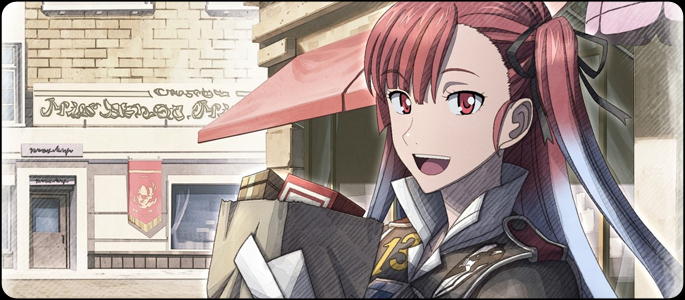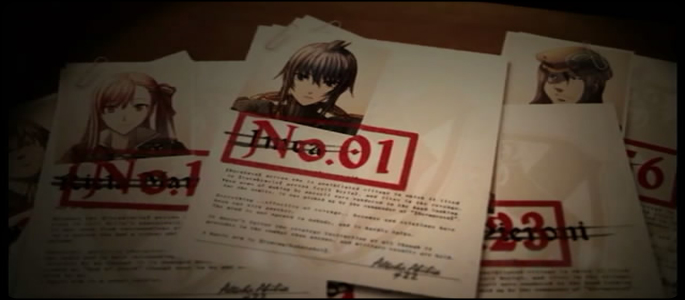First things first, players who’ve gotten their hands on either of the previous two Valkyria Chronicles games have been down this road and know what to expect from a new installment’s core mechanics. That said, there are however several noteworthy changes and additions that make Valkyria Chronicles 3 a different experience indeed.
While the first game used a story book as its base of navigation, and the second went with an overhead view of a military school campus, the third now goes with maps of battlefields. Each chapter begins with a section of a map, upon which a home base, battle locations, and story points are marked. Things must move in chronological order though, so not all cutscenes or battles will be immediately available. At the end of a chapter, players are presented with a new map featuring a different part of the war zone, but at any time between segments, one can turn back to previous maps and replay its skirmish or story scenes.
Several times, I’ve been given options as to what course of action I’d take in pursuing my goal, something completely new to the series. In the first two games, the story battles were the meat and potatoes of the game, and that was it. Players had options to replay skirmishes over, and in the epilogue could redo story battles, but never were there two, clearly different paths before the player. For example, sometimes there will be options like “Cut the enemy off and fight head on, in the woods” appearing on the map as A, whereas battle B is “Go around the hills and meet them in Brule” or some similar scenario. The player can look over the terrain, enemies, items up for grabs and winning conditions before choosing, but only one path can be picked, logically. (After clearing either battle A or battle B, the unpicked fight will become unavailable, because doing both would be nonsensical Back to the Future fodder.) This is a welcome touch of non-linearity for a series that hasn’t had much of it.
Soldier progression in Valkyria Chronicles 3 is the best it’s been in the series. As players may recall, the first game had players using EXP to give all-encompassing level-ups to all members of any given class, which worked well enough. The second featured a deeper class system and enables class changes and upgrades among individual members, in addition to the first game’s EXP system. The problem with the second game’s system was that changing classes required spending “badges,” which were earned almost completely at random among battle participants. This somewhat broken system led to a frustrating amount of badge grinding. In Valkyria 3, however, class changes can be done by any character at any time. Want to make Kurt a sniper? You can, right away, without having to spend any points. Didn’t like how that worked out? Then change him back to a storm trooper or try being something else, fool. No worries. It should be noted that this isn’t simply making the game easier, though, because there is definitely strategy to the class changes.

For example, one character might simply have a lot of HP. So do you want to change this guy to a super-defensive, always-staying-alive Armored Tech, or do you want a scout with a little more HP than your other scouts? Mix things up, without fear of having to badge grind just for another hour just to get back what you already had. Additionally, getting level-ups in other classes makes the character not only strong in his/her own class, but will be helpful when changing classes as well. A chracter who gained a few levels as one job before becoming another will usually keep better stats in the transition. Characters gain these class level-ups by participating in battles. If a character is deployed and takes action, that person will get the class experience at the end of a battle, so long as he/she wasn’t captured.
Beyond that, the old EXP system is also in place, but this time around, EXP is not applied to one class at a time, it’s applied to one attribute at a time. Whereas before, the player would spend, say, 9,000 EXP to upgrade all aspects of every scout in the group, the player now takes EXP and puts it towards HP, accuracy/defensive firing, agility/dodging, power of co-operative attacks, or learning new Orders. So the player fights a battle, gets a bunch of EXP, then clicks the base camp, let’s say. One can then choose which aspect to upgrade; if HP is chosen, then every group member’s HP will increase by two or three points, regardless of class or level within that class. The way everything works out is great. Strategic, yet user-friendly, it’s the best character growth system the series has seen so far.
There are also a few differences in how a KO is handled. Now, support class members can revive a fallen comrade from a distance with an item. When this is done, that fighter stands back up and is ready to go in the very spot he was gunned down, just not with full HP. Of course, if the enemy that killed your friend is still around, he may very well do so again, so future players be careful in how and when you use this.
In the first game, when a character was KO’d, a the player had three turns to try and rescue him/her before that character permanantly died (except story characters). In the second, failure to rescue within the alloted time meant a lengthy stay in the hospital, during which that character would have to sit out any combat. In the third, there is no hospital or permadeath, which will please some players and perhaps disappoint others. But, to add challenge to make up for lost consequence, the player now only has one turn to revive a fallen ally. One can do it with a medic from a distance as described above, remove the character from the battlefield via the menu for two command points, or by another member making physical contact. Routing the downed character via menu will make him/her unavailable for the rest of the battle, but there will be no loss of experience. Doing so by the good old fashioned personal rescue will allow the character to bounce back into action for the next turn, a feature which some may call a little on the easy side when compared to the longer timeout periods of the first two VC titles.
Players can now steer their characters towards learning of select, desirable new potentials by way of a Master Table, viewable in the base camp. Others are specific to the character in question and can’t be changed, like before. Certain character will also gain special abilities at certain points in the story, the use of which costs a Special Point as well as the usual command point. I expect just the main three of Kurt, Riela, and Imca to have these by the end, but perhaps there will be others. I could be totally wrong; that’s why this is a preview. As of right now, Kurt has an ability that lets him move simultaneously with a couple of other teammates, and then rain down united fire on Kurt’s enemy of choice. Imca recently got one that lets her simultaneously target like every enemy within range. Riela doesn’t have hers yet, but the demo I played had her parading around as a Valkyria, so ah…I kinda already know that’s coming. As if the game’s artwork didn’t make it obvious enough.

Speaking of these characters, the squad they make up is called “The Nameless,” or more officially, Gallian Military Squad 442. Members of this group have their names blotted out from Gallia’s official history and are referred to as numbers instead; this is where the game gets its subtitle, “The Unrecorded Chronicles.” Becoming a member of The Nameless involves pissing off the military higher ups or otherwise being a disgrace. Its members have done things like botch assignments, disobey orders, cause drunken rackets, and so on. Kurt Irving is put in command of these military Mighty Ducks after a finding himself accused of treason. Where exactly the logic of putting treason suspects in charge of army squads comes in, I’m not sure, but I…guess the game had to roll on somehow. Being outcasts and punished soldiers, they’re generally given tough orders.
The story is a lot more serious in its tone than the last time around. It takes place at the same time as the original Valkyria Chronicles, and much like that game, it’s a war story, whereas the second was more of a coming-of-age story happening at a time of war. Many characters have their schticks and such, but the characters have demonstrated functional chemistry so far.
Sega has not yet officially announced a North American localization of Valkyria Chronicles 3, but since the first two came over and both did well, it seems something of a safe bet. Nothing is certain in this business though, so until an announcement is made, any fans of the series should definitely look forward to this third installment. As of the 30 hours I’ve logged, it’s a great game, and it’d be a shame for English speakers not to get this.








